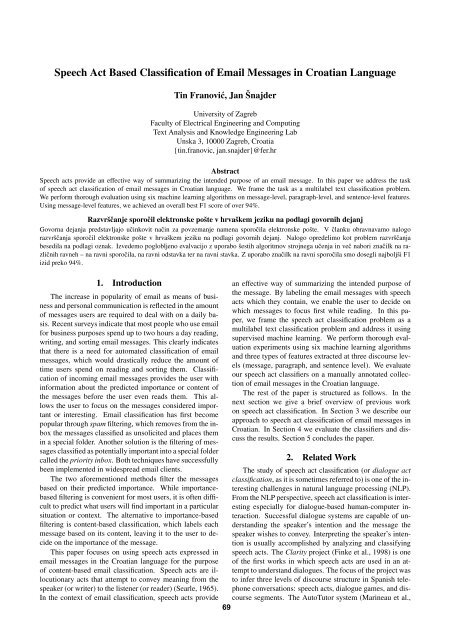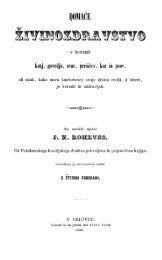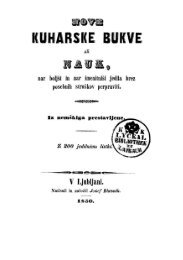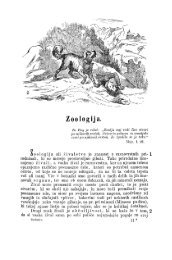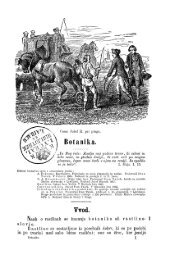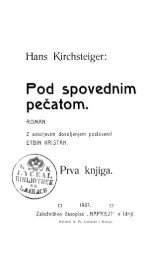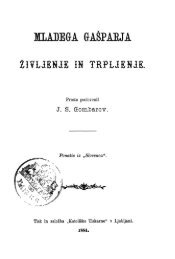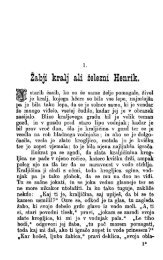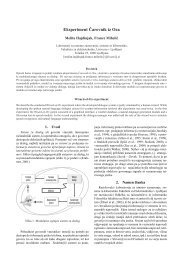Proceedings - Natural Language Server - IJS
Proceedings - Natural Language Server - IJS
Proceedings - Natural Language Server - IJS
Create successful ePaper yourself
Turn your PDF publications into a flip-book with our unique Google optimized e-Paper software.
Speech Act Based Classification of Email Messages in Croatian <strong>Language</strong><br />
Tin Franović, Jan Šnajder<br />
University of Zagreb<br />
Faculty of Electrical Engineering and Computing<br />
Text Analysis and Knowledge Engineering Lab<br />
Unska 3, 10000 Zagreb, Croatia<br />
{tin.franovic, jan.snajder}@fer.hr<br />
Abstract<br />
Speech acts provide an effective way of summarizing the intended purpose of an email message. In this paper we address the task<br />
of speech act classification of email messages in Croatian language. We frame the task as a multilabel text classification problem.<br />
We perform thorough evaluation using six machine learning algorithms on message-level, paragraph-level, and sentence-level features.<br />
Using message-level features, we achieved an overall best F1 score of over 94%.<br />
Razvrščanje sporočil elektronske pošte v hrvaškem jeziku na podlagi govornih dejanj<br />
Govorna dejanja predstavljajo učinkovit način za povzemanje namena sporočila elektronske pošte. V članku obravnavamo nalogo<br />
razvrščanja sporočil elektronske pošte v hrvaškem jeziku na podlagi govornih dejanj. Nalogo opredelimo kot problem razvrščanja<br />
besedila na podlagi oznak. Izvedemo poglobljeno evalvacijo z uporabo šestih algoritmov strojnega učenja in več nabori značilk na različnih<br />
ravneh – na ravni sporočila, na ravni odstavka ter na ravni stavka. Z uporabo značilk na ravni sporočila smo dosegli najboljši F1<br />
izid preko 94%.<br />
1. Introduction<br />
The increase in popularity of email as means of business<br />
and personal communication is reflected in the amount<br />
of messages users are required to deal with on a daily basis.<br />
Recent surveys indicate that most people who use email<br />
for business purposes spend up to two hours a day reading,<br />
writing, and sorting email messages. This clearly indicates<br />
that there is a need for automated classification of email<br />
messages, which would drastically reduce the amount of<br />
time users spend on reading and sorting them. Classification<br />
of incoming email messages provides the user with<br />
information about the predicted importance or content of<br />
the messages before the user even reads them. This allows<br />
the user to focus on the messages considered important<br />
or interesting. Email classification has first become<br />
popular through spam filtering, which removes from the inbox<br />
the messages classified as unsolicited and places them<br />
in a special folder. Another solution is the filtering of messages<br />
classified as potentially important into a special folder<br />
called the priority inbox. Both techniques have successfully<br />
been implemented in widespread email clients.<br />
The two aforementioned methods filter the messages<br />
based on their predicted importance. While importancebased<br />
filtering is convenient for most users, it is often difficult<br />
to predict what users will find important in a particular<br />
situation or context. The alternative to importance-based<br />
filtering is content-based classification, which labels each<br />
message based on its content, leaving it to the user to decide<br />
on the importance of the message.<br />
This paper focuses on using speech acts expressed in<br />
email messages in the Croatian language for the purpose<br />
of content-based email classification. Speech acts are illocutionary<br />
acts that attempt to convey meaning from the<br />
speaker (or writer) to the listener (or reader) (Searle, 1965).<br />
In the context of email classification, speech acts provide<br />
an effective way of summarizing the intended purpose of<br />
the message. By labeling the email messages with speech<br />
acts which they contain, we enable the user to decide on<br />
which messages to focus first while reading. In this paper,<br />
we frame the speech act classification problem as a<br />
multilabel text classification problem and address it using<br />
supervised machine learning. We perform thorough evaluation<br />
experiments using six machine learning algorithms<br />
and three types of features extracted at three discourse levels<br />
(message, paragraph, and sentence level). We evaluate<br />
our speech act classifiers on a manually annotated collection<br />
of email messages in the Croatian language.<br />
The rest of the paper is structured as follows. In the<br />
next section we give a brief overview of previous work<br />
on speech act classification. In Section 3 we describe our<br />
approach to speech act classification of email messages in<br />
Croatian. In Section 4 we evaluate the classifiers and discuss<br />
the results. Section 5 concludes the paper.<br />
2. Related Work<br />
The study of speech act classification (or dialogue act<br />
classification, as it is sometimes referred to) is one of the interesting<br />
challenges in natural language processing (NLP).<br />
From the NLP perspective, speech act classification is interesting<br />
especially for dialogue-based human-computer interaction.<br />
Successful dialogue systems are capable of understanding<br />
the speaker’s intention and the message the<br />
speaker wishes to convey. Interpreting the speaker’s intention<br />
is usually accomplished by analyzing and classifying<br />
speech acts. The Clarity project (Finke et al., 1998) is one<br />
of the first works in which speech acts are used in an attempt<br />
to understand dialogues. The focus of the project was<br />
to infer three levels of discourse structure in Spanish telephone<br />
conversations: speech acts, dialogue games, and discourse<br />
segments. The AutoTutor system (Marineau et al.,<br />
69


